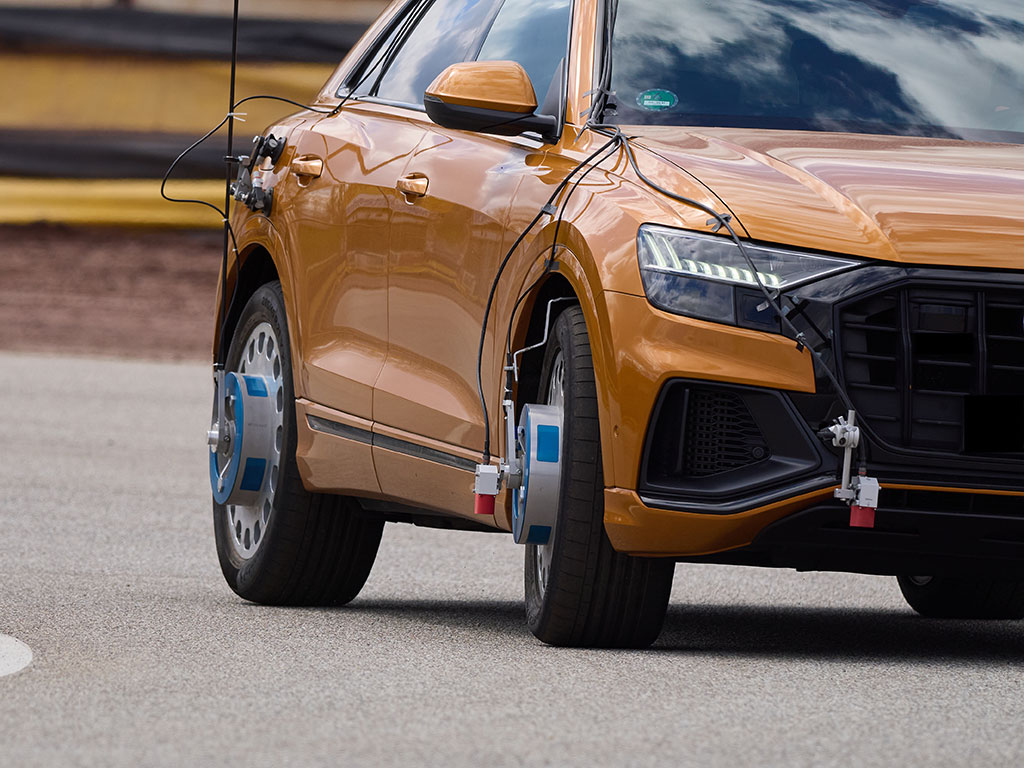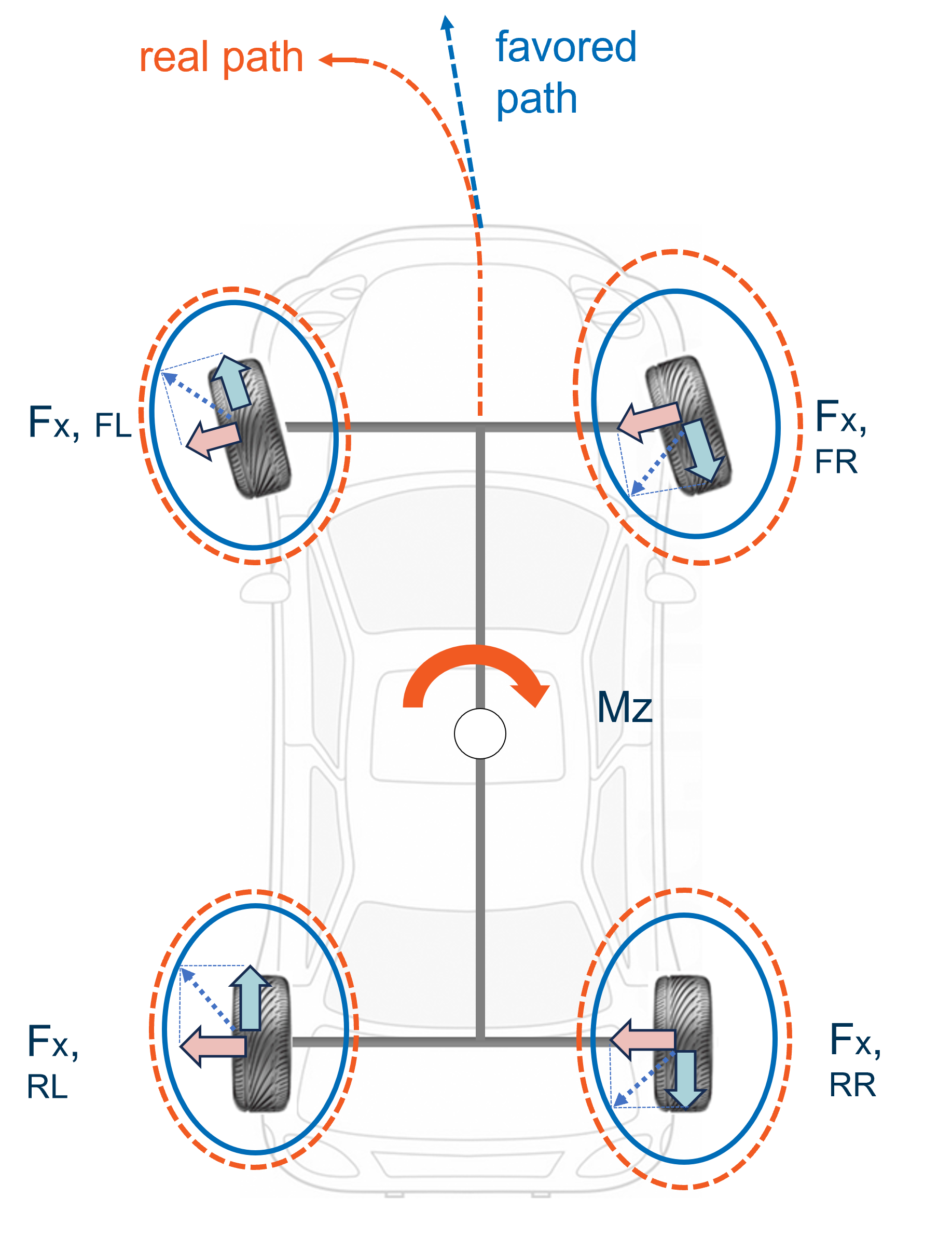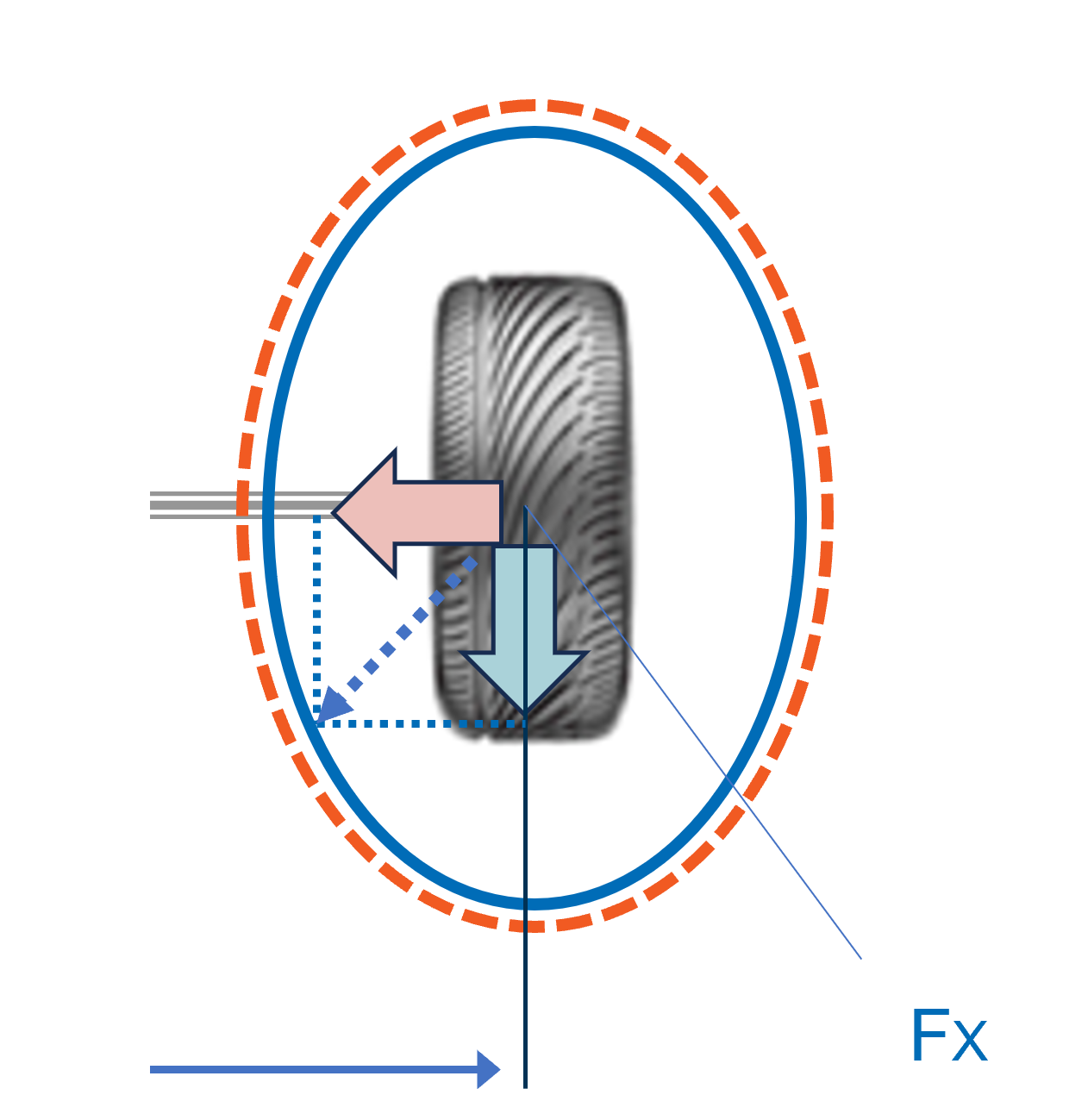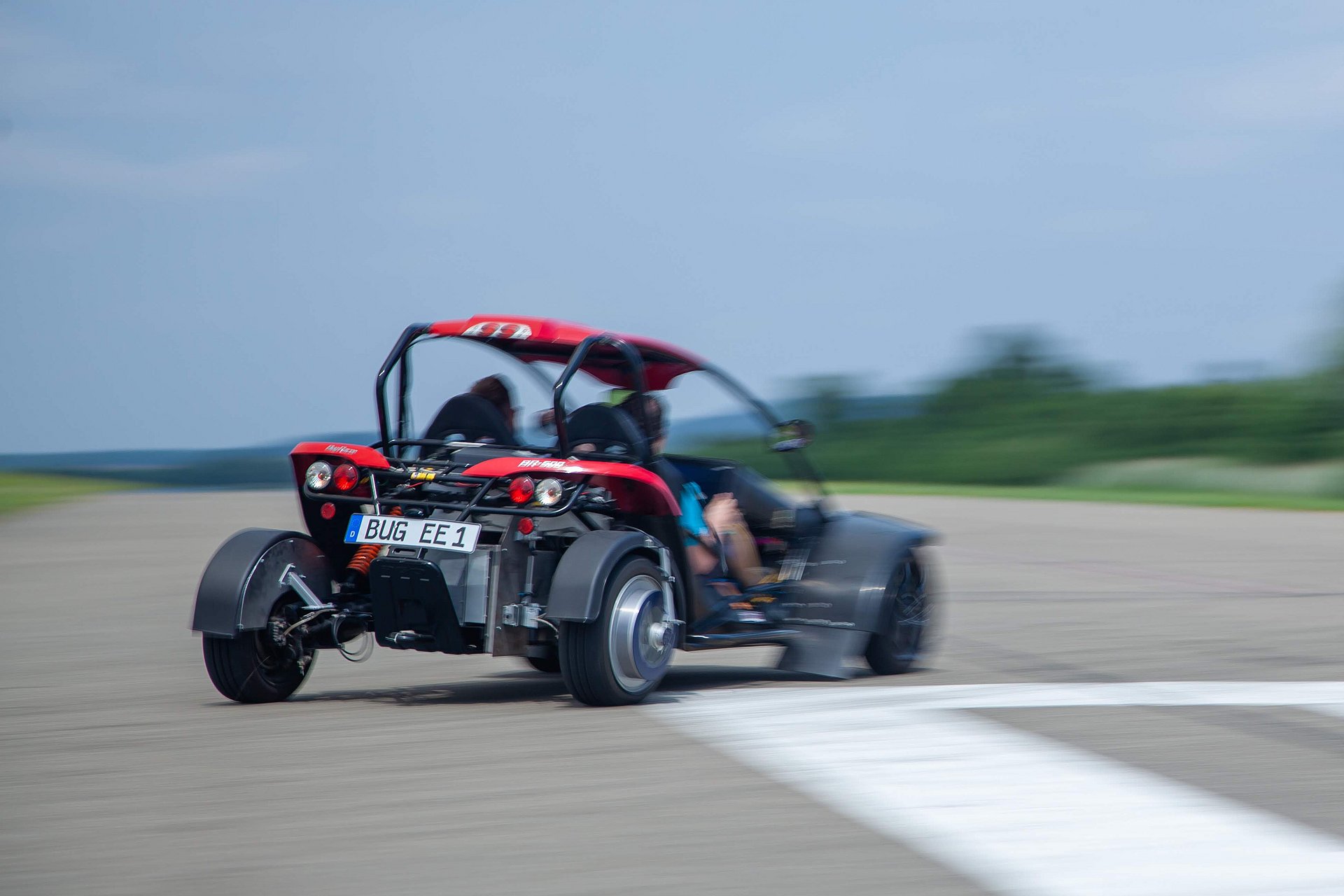차량에 대한 "지능적인" 주행 안전성 그리고 주행 편의성에 대한 요구는 계속 증가하고 있습니다. 전기차에 대하여 차량의 휠을 개별적으로 구동할 수 있는 능력, 전동화 파워트레인을 통한 극한 가속, 전기차 배터리의 무게로 인해 엔지니어는 전기 자동차의 핸들링을 튜닝할 때 새로운 수많은 문제에 직면합니다. 그리고 파워트레인의 전동화로 인해 운전자는 스티어링 휠에 더 빠르게 개입할 수 있고 차체와 휠을 제어하여 "컴포트", "스포츠" 또는 "에코"와 같은 다른 주행 모드로 설정할 수 있습니다.
토크 벡터링(torque vectoring)의 정의와 원리
"토크 벡터링"은 EV에서의 주행 거동을 조절하는 현대의 차량 아키텍처에서 점점 더 많이 사용되고 있는 기술입니다. 각각의 차량 바퀴에 적용되는 구동 및 제동 토크가 다르게 제어됩니다. 차량 개발 단계에서 토크 벡터링 기술을 적용하기 위한 전제 조건이자 과제는 정밀하고 동기화된 데이터 수집을 통한 차량 역학 테스트입니다. 차량 주행 역학은 주로 주행 안정성(stability), 측면 슬립(slip), 요(yaw) 및 롤(roll)을 나타내는 차량의 측면 역학을 다룹니다. 그것은 주행, 제동, 승차감을 포함하는 종방향 동역학과 수직 동역학으로 다시 나뉩니다. 차량의 종방향 바퀴에 대한 주행 슬립과 제동 슬립을 연구하여 주행 및 제동 효율을 향상시킬 수 있습니다.
토크 벡터링의 초점은 휠의 토크 분배를 최적화하는 것입니다. 차량을 전자식으로 튜닝하여 토크를 적응시키고 주행라인을 수정합니다. 예를 들어 조향 중에 오버스티어링된 차량은 바깥쪽 바퀴보다 안쪽 바퀴에 더 큰 토크를 인가하여 본래 주행 경로로 복귀할 수 있습니다. 이러한 방식의 개입은 차량에 다른 기계적인 하드웨어의 추가 없이 차량의 핸들링을 컨트롤 할 수 있습니다. 차량의 각각의 휠에 대한 토크 분배를 최적화하여 이와 같이 주행 안정성을 개선할 수 있습니다.
이와 같이 차량 개발 과정에서 토크 벡터링을 적용하면 차량 안전성을 높이고 더 다이나믹한 주행 특성도 얻을 수 있습니다. 동일한 차량 플랫폼에서 주행에 직접 또는 간접 개입하는 방식으로 컴포트 모드에서 스포츠 모드까지 다양한 주행 특성을 구현할 수 있습니다. 차량이 오버스티어 상태인지, 언더스티어인지 또는 뉴트럴 스티어 상태인지를 확인하고 개별 휠에 대한 토크를 조정할 수 있습니다.
| 토크 스티어 측정 기술 문의 |
토크 벡터링을 구현하는데 데이터 계측 기술을 적용할 수 있습니까?
전기 자동차에서 이러한 측정 변수들은 휠 포스 트랜스듀서(Wheel Force Tranducer)를 사용하여 각 휠에서 개별적으로 측정됩니다. 이러한 6분력계(WFT) 센서는 x, y, z 방향의 힘과 축에 대한 모멘트를 측정합니다. 각 휠의 각도와 휠 속도도 주행 거동 특성을 조사하는 데 관련이 있습니다. 이를 위해 추가 센서를 사용하여 차량의 각 바퀴의 속도 벡터 정보를 동시에 기록할 수 있습니다. 이러한 방식으로 힘 벡터와 토크를 속도 벡터와 함께 분석할 수 있어서 마찰 계수에 대한 결과를 도출할 수 있습니다.
빠른 속도로 샘플링 동기화되고 정밀하게 측정된 측정 데이터는 힘과 토크의 완벽한 계측 및 평가에 필수적입니다. 정밀하게 측정된 데이터를 바탕으로 ADAS(Advanced Driver Assistance Systems) 및 ADS(Automated Driving Systems)의 더 빠른 제어 루프를 평가할 수 있습니다. 측정된 데이터를 기반으로 한 시뮬레이션을 위한 데이터인 차량 속도, 각도, 가속도 및 각속도의 조합, 휠에서 측정된 차량 모멘트 및 힘의 조합은 더 정밀하고 포괄적인 입력 데이터가 필요합니다. 또한 전기차를 위한 특별한 측정 센서의 기술은 차량의 주행에 미치는 영향을 최소화하고 전자기 간섭(EMC) 및 환경 영향에 강해야 합니다.
전기차 R&D 분야에서의 토크 벡터링 어플리케이션으로 Magdeburg의 Otto-von-Guericke University 기계 공학과의 연구 프로젝트가 있습니다. 여기서 imc WFT 센서는 모든 지형에 대한 테스트 차량의 마찰 계수를 추정하고 평가하는 데 사용되었습니다. 이 프로젝트의 목표는 싱글 전기 모터드라이브가 장착된 차량의 차량 동역학 제어를 실현하는 것입니다. 이를 위해서는 매우 정확하고 동기화된 측정 데이터가 필요합니다.
토크 벡터링 적용을 목적으로 하는 차량 동역학 테스트에서는 차량의 주행 거동과 제어 개입에 대한 결과를 평가하고 튜닝하기 위한 포괄적이고 정확하며 동기화된 측정 데이터를 제공해야 합니다. 차량 휠로부터의 측정 데이터는 시뮬레이션과 테스트 벤치 테스트의 기반이자 시작이기도 합니다. 이러한 차량에 대한 실차 테스트는 많은 비용이 들고 테스트 트랙에서의 시간이 제한적이기 때문에 측정 기술은 직관적이고 빠른 설치와 안전을 보장하며 데이터를 계측해야 합니다. 또한 내장된 교정 메커니즘을 통한 데이터 신뢰성을 제공하는것이 필요합니다.
Autor: Florian Sailer, Business Development Expert Vehicle Dynamics
이 기사가에 더 흥미가 있으시다면, 차량의 실차 테스트 및 차량 역학을 위한 솔루션에 대한 자료도 확인해보세요.
Stay up to date:









